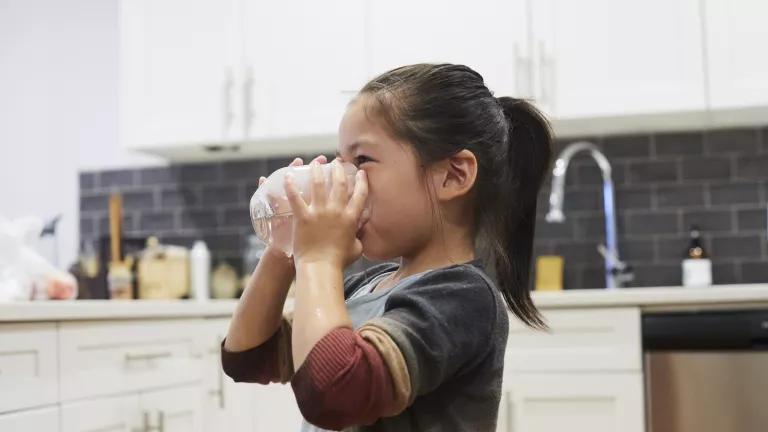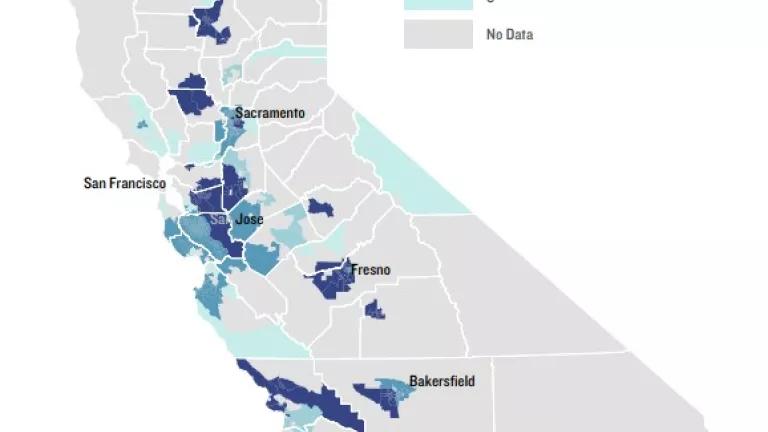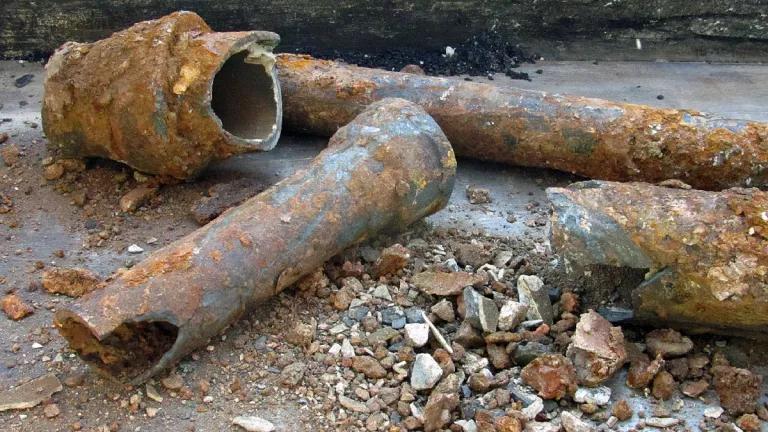EPA Refuses to Protect Children from Perchlorate-Contaminated Tap Water

The agency defies a court order, the law, and science.
UPDATE: On June 18, 2020, EPA Administrator Andrew Wheeler announced it will not regulate perchlorate in public water supplies, defying a court-ordered consent decree requiring the agency to issue a drinking water standard for the widespread contaminant perchlorate.
In an extraordinary decision, President Trump’s Environmental Protection Agency (EPA) administrator Andrew Wheeler has decided to defy a court-ordered consent decree requiring the agency to issue a drinking water standard for the widespread contaminant perchlorate. Studies show this chemical poses threats to the brain development of fetuses and young infants and has been found in millions of Americans’ tap water. The decision, which not only ignores the science but violates a court order and the law, is expected to be announced publicly in coming weeks.
What is perchlorate?
Perchlorate is a component of rocket fuel, munitions, and fireworks that the Obama EPA determined in 2011 requires regulation because of the health threat it poses to the drinking water of as many as 16 million Americans. Wheeler is purporting to reverse that determination.
Perchlorate contamination often occurs as a result of pollution from Department of Defense (DOD) or DOD contractor facilities. EPA required limited national testing of perchlorate in drinking water from 2001 to 2005, which was the basis of its finding of widespread perchlorate contamination. No nationwide monitoring has been required over the past 15 years, so few of us know if it’s in our tap water. Because perchlorate threatens the health of fetuses, infants, and young children especially, the American Academy of Pediatrics, multiple independent scientists, and many states (as discussed below) have weighed in, urging EPA to set a strict standard for perchlorate in drinking water. They have been ignored by Wheeler.
What is the regulatory status of perchlorate and what did the court require?
Perchlorate is the first drinking water contaminant that EPA has proposed to regulate in nearly 24 years under the provisions of the Safe Drinking Water Act Amendments of 1996 for setting new standards for unregulated contaminants. The Obama EPA found in 2011 that a perchlorate drinking water standard was needed to protect health, especially that of vulnerable fetuses and young children. This finding triggered a legal duty to regulate perchlorate. When EPA was slow to issue standards after that finding, NRDC sued, and a federal judge hearing the case said that EPA needs “a fire lit under them” to address the urgent problem. In response, the agency agreed in a court-approved consent decree to propose a perchlorate drinking water standard by October 2018 and to finalize it by late 2019. EPA sought extensions, citing the need for more study, so the standard is now due in June 2020.
What was EPA’s new decision on perchlorate?
In an astonishing step, Wheeler is purporting to revoke the agency’s 2011 finding that a perchlorate standard is needed to protect the health of millions of Americans, especially fetuses, infants, and young children. EPA therefore will not comply with the court-ordered consent decree requiring a final drinking water standard for perchlorate by June 2020 and will not comply with the legal requirement to set a standard once it has formally determined that one is necessary.
To explain why it’s revoking its previous finding, EPA now contends its 2008 health advisory for perchlorate in drinking water—set at 15 parts per billion or ppb—is far more protective of health than needed. That 15 ppb health advisory was based on a 2005 National Academy of Sciences study. Instead, Wheeler now finds a level of 56 ppb would be safe, and perhaps even 90 ppb would be fine. EPA admits that a standard of 56 ppb would allow those kids exposed to perchlorate in drinking water at above this level to have an average IQ loss of two points. People at the lower end of the IQ spectrum could lose far more IQ points. In concluding 56 ppb is safe, the agency would allow an unprecedented level of adverse impact on children’s brain development. It also has decided to ignore all other health effects of perchlorate that scientists say can occur at lower doses, rejecting its own previous analysis. EPA’s new supposedly “safe” level is nearly 10 times higher than California’s standard for perchlorate of 6 ppb. It also is 28 times higher than Massachusetts’s standard of 2 ppb. California experts have now recommended that to protect bottle-fed infants, the safe level should be dropped to 1 ppb. Similarly, New Jersey’s Drinking Water Quality Institute, a blue-ribbon panel of scientists, recommended a maximum safe level of 5 ppb.
EPA now says that, based on its “reanalysis” of the 15-year-old testing (and some data from California and Massachusetts since those states adopted standards), perchlorate isn’t found in enough water systems at a level above EPA’s conveniently high new “safe” levels to trigger a need to regulate. The agency did not analyze how many water systems across the country exceed a lower threshold such as 2 to 6 ppb, though its previous data set would suggest that millions of Americans may be unknowingly drinking water exceeding those levels.

Reactions of the American Academy of Pediatrics and state and Tribal authorities
The president of the American Academy of Pediatrics filed a letter with EPA in 2019 when the agency hinted in its proposal that it was considering several options for a standard, including possibly revoking its finding that a perchlorate standard is needed, stating:
“AAP is particularly concerned that EPA is considering withdrawing its 2011 determination to regulate perchlorate, relinquishing national oversight over a chemical with well-established health risks in drinking water. This would set a precedent inconsistent with EPA’s stated mission to protect public health. AAP urges the EPA to set a stronger MCLG [maximum contaminant level goal] for perchlorate that is based on all available evidence of potential harms to protect public health. A lower MCLG will allow EPA to generate reporting data that more accurately portrays the populations at risk and to better protect vulnerable populations.”
Several state and Tribal government experts also weighed in with EPA, urging a far stricter standard:
- California, which is considering reducing its standard from 6 ppb to 1 ppb, was highly critical of EPA’s supposed reassessment of the science, stating it is “unreasonable not to consider neonates or young infants as an important susceptible subpopulation,” and critiquing the decision to allow an average 2 percent IQ loss as acceptable.
- Massachusetts, which has adopted a 2 ppb standard to protect vulnerable infants and fetuses, also objected, stating that the state “does not support U.S. EPA’s proposed options for addressing perchlorate in drinking water, which are likely to allow for significant adverse public health impacts.” The state suggested that, based on traditional EPA analyses, an appropriate standard would be 1.9 ppb.
- New Jersey, whose experts proposed a 5 ppb standard, stated: “The decision to use a predicted decrease in children’s IQ of 2 percent as the basis for the perchlorate MCL [micrograms per liter] does not appear to be well supported or protective of public health. It should be noted that this decision was not reviewed by the peer reviewers of U.S. EPA’s approach for the risk assessment of perchlorate.” The state noted that, using traditional EPA assumptions and analysis, a standard of 8 ppb would be called for.
- New York also was critical of EPA, noting that the agency’s own Clean Air Scientific Advisory Committee has recommended a 1 percent IQ loss as significant, and that EPA’s proposal fails to adequately consider protections needed for infants, for example.
- Similarly, Tribal authorities expressed their alarm. For example, the Salt River Pima-Maricopa Indian Community in Arizona noted that while even 18 ppb, the lowest standard EPA was considering, “may be attainable for most public drinking water systems, it does not make that a safe number….There are numerous states that have already adopted lower limits…” The Tribe went on to note:
“Withdrawal of regulation will only encourage the industry to abandon any preventative measures to contain current contamination.…The community, and similarly, other Tribal nations, rely on the EPA requirements and standards to support our efforts to keep Tribal waters safe from environmental health hazards. The agency’s guidance/regulation may also help Tribal nations enforce possible contamination in the absence of existing local environmental rules and regulations (which could take some years to achieve). Native American communities already have a higher diabetes prevalence….Having diabetes prevalence and possible exposure to perchlorate, which affects the thyroid, would only place the community at a higher health disadvantage. Furthermore, Native American communities may not always have the resources to provide proper medical assistance and already experience environmental injustice…based on where reservations are located. In conclusion, it is in the best interest of the community and its members to expect and follow the most stringent and protective drinking water regulations in order to protect a health-wise vulnerable population.”
- A 2011 study of dozens of state perchlorate standards/action levels for drinking water (or for cleanup of groundwater that is expected to be used for drinking water) found that the vast majority of them were at or substantially below EPA’s supposedly “safe” level of 56 ppb.

So why would EPA refuse to set a standard for perchlorate?
When EPA was first considering establishing a drinking water standard for perchlorate in the early 2000s, documents NRDC obtained through litigation under the Freedom of Information Act revealed that the DOD and its contractors mobilized a massive campaign to stop the agency from moving forward. They succeeded in buying time by getting the National Academy of Sciences to conduct a study, helping to craft the crucial charge questions to NAS and seeking to stack the panel. Indeed, a consultant of one of the biggest DOD perchlorate polluters, Dick Bull, was placed on the panel despite NRDC’s providing evidence to NAS showing his recent pay from the industry. While Bull eventually left the panel, at least one other committee member also had apparent conflicts.
Despite this, the final NAS report in 2005 recommended a reference dose (0.7 micrograms per kilogram of body weight) upon which EPA based its 2008 health advisory of 15 ppb. Subsequent studies and analyses have indicated that an even stricter standard for perchlorate is needed, which is what states such as California, Massachusetts, New Jersey, and New York, the American Academy of Pediatrics, and others have relied upon to make their determinations.
Despite this new evidence, the DOD and an army of industry opponents to a strict drinking water standard have succeeded in shutting down the process. Industry advocates, including the American Chemistry Council (the chemical industry trade association), the Perchlorate Study Group (large industrial manufacturers and users of perchlorate, mostly DOD contractors), and industry “hired gun” scientist consultants like Gradient, have all been pressing EPA to not set a standard.
The American Water Works Association (AWWA), the water utility industry’s biggest trade association, recommended for years that EPA set a perchlorate standard for drinking water. For example, AWWA said in a July 2, 2007 letter to EPA, “Building upon our position previously communicated to EPA in letters on February 2, 2005, and May 27, 2005, we recommend that EPA now make the decision to regulate perchlorate. AWWA believes that EPA has enough information to make a positive regulatory determination, and then to move forward with a proposed perchlorate regulation consistent with the requirements of the Safe Drinking Water Act.” In further analysis, the AWWA found in 2013 that “National compliance costs for a perchlorate MCL ranging from 2 to 24 [ppb] is smaller than estimated compliance costs for other drinking water regulations….The relatively low national compliance costs reflect the small number of public water systems (PWSs) expected to be affected by a potential MCL of 4 [ppb].” However, AWWA has now changed its tune and joined the bandwagon with its industry allies, filing comments in 2019 that oppose setting a standard for perchlorate.
Conclusion
EPA’s cynical decision to defy a court order and the law, and to ignore the science that, as the American Academy of Pediatrics has said, dictates a strong perchlorate standard to protect vulnerable kids, is a deeply disturbing violation of the agency’s mission. It must be reversed.




